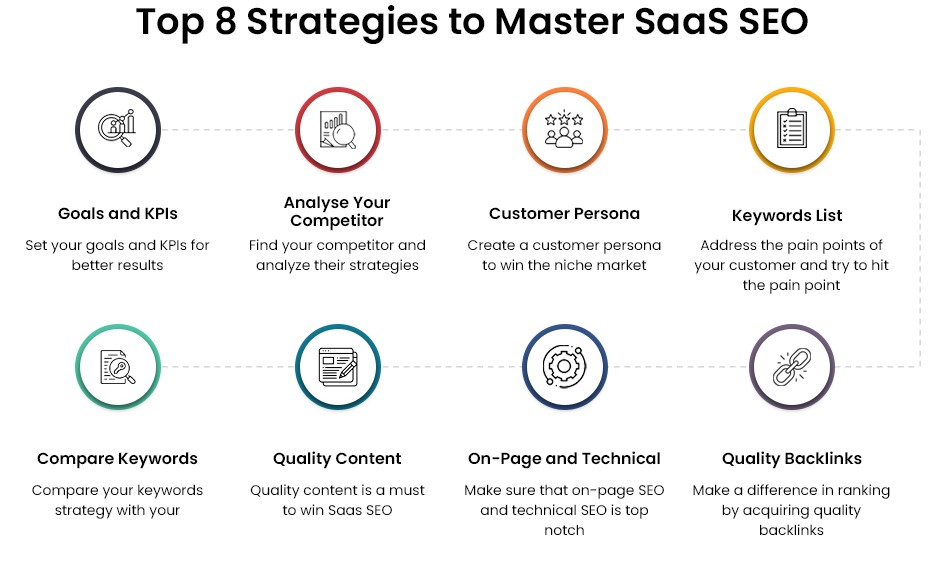
These days, the Software as a Service (SaaS) model is showing rapid growth. It is, of course, an excellent time to expand your SaaS brand. However, beating your strong competitors in the market might feel like a task right now. Top SaaS companies often have a strong search engine presence. However, implementing effective SaaS SEO can be challenging. While there are no rigid rules, proven SEO strategies can help you aim for top positions on Google SERPs.
This blog will discuss various strategies to drive growth with SaaS SEO. So, read along!
Understanding SaaS SEO and Its Importance
SaaS SEO helps boost organic traffic to your website. It employs strategies that help you rank higher on Google SERPs. The process usually includes on- and off-page SEO and technical SEO.
With the help of these techniques, you can achieve top ranking for related searches. This, in particular, serves as a useful form of inbound marketing. All in all, the significance of SEO for SaaS cannot be overstated. It can be the key factor that sets your SaaS business apart from competitors who rely on outbound and paid marketing strategies.
Why SaaS Businesses Must Invest in a Solid SEO Strategy Early On:
SaaS SEO Has Compounding Effects Over Time
SaaS giants like HubSpot focus on content marketing and SEO because of the compounding benefits over time. In simple words, the progress is slow initially; however, the SEO implementation helps generate results with each new piece of content
SEO Works in Unison with Other Marketing Channels
SEO functions as a component of a comprehensive strategy. It doesn’t give results as an isolated technique. Content created for SEO can be repurposed across various channels, such as email and social media marketing. Additionally, SEO enhances brand awareness, credibility, and authority.
SEO Reduces SaaS Cost Per Acquisition (CPA)
Paid advertising through PPC or social media can be expensive. In contrast, SEO requires a relatively lower investment. This makes it an effective way to reduce your CPA.

1. Set Your Goals and KPIs
It’s crucial to set the right objective or goal, whether it’s increasing brand awareness or generating significant leads.Besides your goals, it’s important to know the Key Performance Indicators (KPIs) that help you track your progress toward your goals.
These KPIs include click-through rates, revenue, rankings, traffic, etc. For SEO, this means matching corporate goals with pertinent KPIs to achieve quantifiable results.
2. Find Your Competitors and Analyze Their Strategies
Learning from your competition can help you improve your SaaS SEO performance by leveraging their strengths and exploiting their faults. To accomplish this, use Organic Research tools to identify competitors, and study their organic traffic trends, top keywords, and pages. Besides, try to conduct a Keyword Gap analysis to find out keywords for which they rank but you do not.
In addition, run a Backlink Gap study to find referring websites that link to your competitors but not to you. Plus, prioritize outreach based on Authority Score and other relevant information.
3. Create Customer Personas
Customer persona is a fictional demonstration of your ideal customer. It covers demographic, psychographic, behavioral, and other needs-based details. These personas are important for customizing content to match search intent, address pain points, and navigate the buyer’s journey effectively. To create them:
-
-
- Use Templates: Begin with a customer persona template.
- Leverage Research Tools: Leverage tools like One2Target to delve into audience demographics, behaviors, and more.
- Segment Your Audience: Divide your audience into distinct groups based on characteristics such as industry, location, and budget.
- Develop Personas: Craft individual personas for each segment using the template.
- Validate and Update: Test personas with actual customers, gather feedback from sales and customer service teams, and regularly revise them to reflect market and behavioral changes.
-
4. Build a Keyword List Around Pain Points
Here’s how to build a keyword list and create content that resonates with potential customers:
-
-
- Identify Pain Points: Brainstorm common questions and goals associated with your product or niche, such as building a sales pipeline.
- Conduct Keyword Research: Utilize tools like the keyword planner a free keyword tool by Google to generate keyword ideas. Filter results for “Informational” intent to focus on top-of-the-funnel keywords.
- Create Content: Develop valuable content around these keywords, incorporating them into titles, headings, URLs, meta descriptions, and body text. Utilize diverse formats like blog posts, videos, podcasts, and infographics, and include storytelling, data, and examples. End with clear CTAs to guide readers forward.
-
5. Create a Comparison Keyword Strategy
Comparison keywords strategy shows the interest and inclination of consumers toward purchasing your product. To locate these keywords and incorporate them into optimized content, try the keyword planner. Additionally, it’s crucial to provide fair comparisons, and product descriptions to meet customer needs and use calls to action.
6. Create Better Content Than Your Competitors
SaaS success is highly dependent on content quality. So, it’s crucial to create content that gives you an edge over your competitors. Quality content helps you draw traffic, increase keyword ranking, and boost conversion rates. Start using tools such as Organic Research to find out how your competitors are performing and where you are lacking.
Consider checking the readability score of your content through tools like Hemingway. This will help readers to easily understand the content. Moreover, you can pull the conversational style in your writing for better engagement, ranking, and visibility.
7. Maximize On-Page and Technical SEO Potential
Improving technical and on-page elements that are essential to site performance can help you achieve success. Important considerations include site performance, mobile friendliness, URL structure, HTTPS security, and meta tags.
Prioritize security, readability, and responsiveness while organizing URLs and creating meta descriptions. To improve your website’s search visibility and user experience, you can use tools such as Site Audit to find and fix several technical SEO issues.
8. Acquire Premium Backlinks for Enhanced SEO
Backlinks, pointing to your website from other websites, are crucial for SEO ranking. These connections demonstrate the reliability and trustworthiness of your website to search engines. To increase organic traffic, focus on high-quality backlinks from reliable and relevant sites.Use techniques such as email outreach, broken link building, unlinked brand mentions, as well as content marketing. You can also employ resources such as the Link Building Tool to configure your URL, target keywords, and information about your potential competitors to find possible backlink sources.
Efficient SaaS SEO Solutions: Partner With Us
Need an immediate solution? Want someone else to handle your business to invest time and energy, WillShall has your back. Although we understand that SEO can be learned, it is more of an experiential technique. Therefore, to guarantee the profitable outcomes, we are committed to help you in all possible ways. Partner with us and find out how to boost your SaaS business.

With a Bachelor’s in Commerce and 15 years of experience in Ecommerce SEO and Shopify Development, I bring extensive expertise to the digital field. As Managing Partner at WillShall Consulting, I lead a team delivering exceptional Digital Marketing, Web Development, and Web Designing services. My passion for innovation and commitment to excellence help businesses thrive in the digital age.





 Call Us
Call Us Email Us
Email Us Video Call
Video Call




